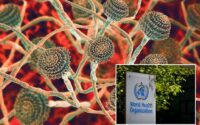Alcohol flush warns of deadly disease: Stanford study
It’s sobering news for the rosy-cheeked drinker.
If you’ve knocked back a few and feel a warm flush creep up your face and ears, you’re not alone.
While often thought of as annoying rather than dangerous, alcohol flush may be a sign of something more serious brewing beneath the surface, a new study suggests.
Roughly 8% of the global population experiences the drunken sensation, mostly in East and Southeast Asian demographics, which has been previously dubbed “Asian glow.” But it’s more than just a nuisance on a night out — the flush is caused by an inherited, genetic hiccup. Those with the gene variant ALDH2*2 are deficient in the ALDH2 enzyme, which is responsible for metabolizing alcohol.
Researchers from Stanford Medicine analyzed what exactly occurs when someone experiences alcohol flushing, making the startling discovery that it can be indicative of life-threatening ailments.


Published in the Science Translational Medicine journal, the research looked at mice that had the same genetic variant.
“We found mice carrying this variant have impaired vascular dilatation,” co-author Joseph Wu, director of the Stanford Cardiovascular Institute, told the Daily Beast. “When treated with alcohol, mice with this variant demonstrated enlarged vascular size, increased vascular thickness, and impaired vascular contraction and relaxation.”
Researchers concluded that there was an inflammatory response in the blood vessels, which restricted blood flow and has the potential to result in coronary artery disease.

Then, they turned their attention to humans who volunteered to participate in the study— people who experienced impaired vascular function even after just “one standard drink.”
But all hope is not lost, Wu emphasized. A diabetes drug called empagliflozin has been shown to reduce the symptoms in the human cells cultured in their lab. The medicine could be a preventative solution for those who are defined as “high risk” and “drink excessively.”
While the drug could prevent the life-threatening effects of alcohol, it won’t halt the booze blush from creeping into your cheeks.
But even those without the blushing alcohol glow aren’t safe from the dangers of drinking, studies have shown. While the flush has been linked to certain cancers, consuming just two drinks per week could be detrimental.
“Research shows that no amount or kind of alcohol is good for your health,” authors from the Canadian Centre on Substance Use and Addiction declared earlier this month on the agency’s new guidance. “Drinking alcohol, even a small amount, is damaging to everyone, regardless of age, sex, gender, ethnicity, tolerance for alcohol or lifestyle.”
While it’s great news for Dry January proponents who might otherwise feel some FOMO on nights out, the World Health Organization echoed a similar sentiment denouncing the use of the “Group 1 carcinogen.” The global agency called alcohol a “toxic, psychoactive and dependence-producing substance,” stating that no amount of alcohol can be healthy.


